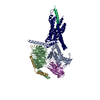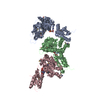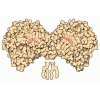[English] 日本語
 Yorodumi
Yorodumi- PDB-6pb1: Cryo-EM structure of Urocortin 1-bound Corticotropin-releasing fa... -
+ Open data
Open data
- Basic information
Basic information
| Entry | Database: PDB / ID: 6pb1 | |||||||||||||||||||||||||||||||||
|---|---|---|---|---|---|---|---|---|---|---|---|---|---|---|---|---|---|---|---|---|---|---|---|---|---|---|---|---|---|---|---|---|---|---|
| Title | Cryo-EM structure of Urocortin 1-bound Corticotropin-releasing factor 2 receptor in complex with Gs protein and Nb35 | |||||||||||||||||||||||||||||||||
 Components Components |
| |||||||||||||||||||||||||||||||||
 Keywords Keywords | SIGNALING PROTEIN / Corticotropin-releasing factor 2 receptor / urocortins1 / Gs protein / GPCR | |||||||||||||||||||||||||||||||||
| Function / homology |  Function and homology information Function and homology informationhistone deacetylase inhibitor activity / corticotropin-releasing hormone receptor activity / corticotrophin-releasing factor receptor activity / corticotropin-releasing hormone receptor 2 binding / positive regulation of corticotropin secretion / positive regulation of behavioral fear response / varicosity / negative regulation of hormone secretion / drinking behavior / response to auditory stimulus ...histone deacetylase inhibitor activity / corticotropin-releasing hormone receptor activity / corticotrophin-releasing factor receptor activity / corticotropin-releasing hormone receptor 2 binding / positive regulation of corticotropin secretion / positive regulation of behavioral fear response / varicosity / negative regulation of hormone secretion / drinking behavior / response to auditory stimulus / negative regulation of appetite / positive regulation of vascular permeability / neuropeptide hormone activity / corticotropin-releasing hormone receptor 1 binding / negative regulation of cell size / Class B/2 (Secretin family receptors) / G protein-coupled peptide receptor activity / response to pain / negative regulation of feeding behavior / positive regulation of calcium ion import / startle response / positive regulation of cAMP/PKA signal transduction / peptide hormone binding / positive regulation of collagen biosynthetic process / associative learning / PKA activation in glucagon signalling / social behavior / developmental growth / Synthesis, secretion, and deacylation of Ghrelin / hair follicle placode formation / D1 dopamine receptor binding / neuropeptide signaling pathway / intracellular transport / vascular endothelial cell response to laminar fluid shear stress / regulation of synaptic transmission, glutamatergic / renal water homeostasis / activation of adenylate cyclase activity / adenylate cyclase inhibitor activity / Hedgehog 'off' state / positive regulation of protein localization to cell cortex / adenylate cyclase-activating adrenergic receptor signaling pathway / negative regulation of blood pressure / T cell migration / Adenylate cyclase inhibitory pathway / D2 dopamine receptor binding / response to prostaglandin E / axon terminus / adenylate cyclase regulator activity / G protein-coupled serotonin receptor binding / adenylate cyclase-inhibiting serotonin receptor signaling pathway / positive regulation of cardiac muscle contraction / cellular response to glucagon stimulus / regulation of insulin secretion / cellular response to forskolin / response to glucocorticoid / regulation of mitotic spindle organization / aerobic respiration / adenylate cyclase activator activity / positive regulation of translation / positive regulation of DNA replication / trans-Golgi network membrane / Regulation of insulin secretion / negative regulation of inflammatory response to antigenic stimulus / sensory perception of sound / positive regulation of cholesterol biosynthetic process / female pregnancy / negative regulation of insulin secretion / G protein-coupled receptor binding / bone development / response to peptide hormone / adenylate cyclase-inhibiting G protein-coupled receptor signaling pathway / positive regulation of interleukin-6 production / platelet aggregation / adenylate cyclase-modulating G protein-coupled receptor signaling pathway / centriolar satellite / cognition / vasodilation / G-protein beta/gamma-subunit complex binding / adenylate cyclase-activating G protein-coupled receptor signaling pathway / long-term synaptic potentiation / Olfactory Signaling Pathway / Activation of the phototransduction cascade / neuron projection development / G beta:gamma signalling through PLC beta / Presynaptic function of Kainate receptors / Thromboxane signalling through TP receptor / G protein-coupled acetylcholine receptor signaling pathway / Activation of G protein gated Potassium channels / Inhibition of voltage gated Ca2+ channels via Gbeta/gamma subunits / G-protein activation / Prostacyclin signalling through prostacyclin receptor / G beta:gamma signalling through CDC42 / Glucagon signaling in metabolic regulation / G beta:gamma signalling through BTK / Synthesis, secretion, and inactivation of Glucagon-like Peptide-1 (GLP-1) / ADP signalling through P2Y purinoceptor 12 / photoreceptor disc membrane / Sensory perception of sweet, bitter, and umami (glutamate) taste / Glucagon-type ligand receptors / Adrenaline,noradrenaline inhibits insulin secretion Similarity search - Function | |||||||||||||||||||||||||||||||||
| Biological species |  Homo sapiens (human) Homo sapiens (human)synthetic construct (others) | |||||||||||||||||||||||||||||||||
| Method | ELECTRON MICROSCOPY / single particle reconstruction / cryo EM / Resolution: 2.8 Å | |||||||||||||||||||||||||||||||||
 Authors Authors | Ma, S. / Shen, Q. / Zhao, L.-H. / Mao, C. / Zhou, X.E. / Shen, D.-D. / de Waal, P.W. / Bi, P. / Li, C. / Jiang, Y. ...Ma, S. / Shen, Q. / Zhao, L.-H. / Mao, C. / Zhou, X.E. / Shen, D.-D. / de Waal, P.W. / Bi, P. / Li, C. / Jiang, Y. / Wang, M.-W. / Sexton, P.M. / Wootten, D. / Melcher, K. / Zhang, Y. / Xu, H.E. | |||||||||||||||||||||||||||||||||
| Funding support |  United States, United States,  China, 2items China, 2items
| |||||||||||||||||||||||||||||||||
 Citation Citation |  Journal: Mol Cell / Year: 2020 Journal: Mol Cell / Year: 2020Title: Molecular Basis for Hormone Recognition and Activation of Corticotropin-Releasing Factor Receptors. Authors: Shanshan Ma / Qingya Shen / Li-Hua Zhao / Chunyou Mao / X Edward Zhou / Dan-Dan Shen / Parker W de Waal / Peng Bi / Chuntao Li / Yi Jiang / Ming-Wei Wang / Patrick M Sexton / Denise Wootten ...Authors: Shanshan Ma / Qingya Shen / Li-Hua Zhao / Chunyou Mao / X Edward Zhou / Dan-Dan Shen / Parker W de Waal / Peng Bi / Chuntao Li / Yi Jiang / Ming-Wei Wang / Patrick M Sexton / Denise Wootten / Karsten Melcher / Yan Zhang / H Eric Xu /    Abstract: Corticotropin-releasing factor (CRF) and the three related peptides urocortins 1-3 (UCN1-UCN3) are endocrine hormones that control the stress responses by activating CRF1R and CRF2R, two members of ...Corticotropin-releasing factor (CRF) and the three related peptides urocortins 1-3 (UCN1-UCN3) are endocrine hormones that control the stress responses by activating CRF1R and CRF2R, two members of class B G-protein-coupled receptors (GPCRs). Here, we present two cryoelectron microscopy (cryo-EM) structures of UCN1-bound CRF1R and CRF2R with the stimulatory G protein. In both structures, UCN1 adopts a single straight helix with its N terminus dipped into the receptor transmembrane bundle. Although the peptide-binding residues in CRF1R and CRF2R are different from other members of class B GPCRs, the residues involved in receptor activation and G protein coupling are conserved. In addition, both structures reveal bound cholesterol molecules to the receptor transmembrane helices. Our structures define the basis of ligand-binding specificity in the CRF receptor-hormone system, establish a common mechanism of class B GPCR activation and G protein coupling, and provide a paradigm for studying membrane protein-lipid interactions for class B GPCRs. | |||||||||||||||||||||||||||||||||
| History |
|
- Structure visualization
Structure visualization
| Movie |
 Movie viewer Movie viewer |
|---|---|
| Structure viewer | Molecule:  Molmil Molmil Jmol/JSmol Jmol/JSmol |
- Downloads & links
Downloads & links
- Download
Download
| PDBx/mmCIF format |  6pb1.cif.gz 6pb1.cif.gz | 214.3 KB | Display |  PDBx/mmCIF format PDBx/mmCIF format |
|---|---|---|---|---|
| PDB format |  pdb6pb1.ent.gz pdb6pb1.ent.gz | 163.9 KB | Display |  PDB format PDB format |
| PDBx/mmJSON format |  6pb1.json.gz 6pb1.json.gz | Tree view |  PDBx/mmJSON format PDBx/mmJSON format | |
| Others |  Other downloads Other downloads |
-Validation report
| Summary document |  6pb1_validation.pdf.gz 6pb1_validation.pdf.gz | 1.2 MB | Display |  wwPDB validaton report wwPDB validaton report |
|---|---|---|---|---|
| Full document |  6pb1_full_validation.pdf.gz 6pb1_full_validation.pdf.gz | 1.2 MB | Display | |
| Data in XML |  6pb1_validation.xml.gz 6pb1_validation.xml.gz | 33.8 KB | Display | |
| Data in CIF |  6pb1_validation.cif.gz 6pb1_validation.cif.gz | 52.1 KB | Display | |
| Arichive directory |  https://data.pdbj.org/pub/pdb/validation_reports/pb/6pb1 https://data.pdbj.org/pub/pdb/validation_reports/pb/6pb1 ftp://data.pdbj.org/pub/pdb/validation_reports/pb/6pb1 ftp://data.pdbj.org/pub/pdb/validation_reports/pb/6pb1 | HTTPS FTP |
-Related structure data
| Related structure data |  20285MC  6pb0C C: citing same article ( M: map data used to model this data |
|---|---|
| Similar structure data |
- Links
Links
- Assembly
Assembly
| Deposited unit | 
|
|---|---|
| 1 |
|
- Components
Components
-Guanine nucleotide-binding protein ... , 3 types, 3 molecules ABG
| #3: Protein | Mass: 43897.789 Da / Num. of mol.: 1 / Mutation: A212G, S352A Source method: isolated from a genetically manipulated source Source: (gene. exp.)  Homo sapiens (human) / Gene: GNAS, GNAS1, GSP, GNAI1 / Production host: Homo sapiens (human) / Gene: GNAS, GNAS1, GSP, GNAI1 / Production host:  |
|---|---|
| #4: Protein | Mass: 37915.496 Da / Num. of mol.: 1 Source method: isolated from a genetically manipulated source Source: (gene. exp.)  Homo sapiens (human) / Gene: GNB1 / Production host: Homo sapiens (human) / Gene: GNB1 / Production host:  |
| #5: Protein | Mass: 7861.143 Da / Num. of mol.: 1 Source method: isolated from a genetically manipulated source Source: (gene. exp.)  Homo sapiens (human) / Gene: GNG2 / Production host: Homo sapiens (human) / Gene: GNG2 / Production host:  |
-Protein / Protein/peptide / Antibody , 3 types, 3 molecules PUN
| #1: Protein | Mass: 45116.375 Da / Num. of mol.: 1 Source method: isolated from a genetically manipulated source Source: (gene. exp.)  Homo sapiens (human) / Gene: CRHR2, CRF2R, CRH2R / Production host: Homo sapiens (human) / Gene: CRHR2, CRF2R, CRH2R / Production host:  |
|---|---|
| #2: Protein/peptide | Mass: 4703.277 Da / Num. of mol.: 1 / Source method: obtained synthetically / Source: (synth.)  Homo sapiens (human) / References: UniProt: P55089 Homo sapiens (human) / References: UniProt: P55089 |
| #6: Antibody | Mass: 15343.019 Da / Num. of mol.: 1 Source method: isolated from a genetically manipulated source Source: (gene. exp.) synthetic construct (others) / Production host:  |
-Non-polymers , 2 types, 9 molecules 


| #7: Chemical | ChemComp-CLR / #8: Chemical | ChemComp-PLM / |
|---|
-Details
| Has ligand of interest | N |
|---|---|
| Has protein modification | Y |
-Experimental details
-Experiment
| Experiment | Method: ELECTRON MICROSCOPY |
|---|---|
| EM experiment | Aggregation state: PARTICLE / 3D reconstruction method: single particle reconstruction |
- Sample preparation
Sample preparation
| Component | Name: Urocortin 1-bound corticotropin-releasing factor 2 receptor in complex with Gs protein Type: COMPLEX / Entity ID: #1-#6 / Source: RECOMBINANT |
|---|---|
| Source (natural) | Organism:  Homo sapiens (human) Homo sapiens (human) |
| Source (recombinant) | Organism:  |
| Buffer solution | pH: 7.4 |
| Specimen | Embedding applied: NO / Shadowing applied: NO / Staining applied: NO / Vitrification applied: YES |
| Specimen support | Details: unspecified |
| Vitrification | Cryogen name: ETHANE |
- Electron microscopy imaging
Electron microscopy imaging
| Experimental equipment |  Model: Titan Krios / Image courtesy: FEI Company |
|---|---|
| Microscopy | Model: FEI TITAN KRIOS |
| Electron gun | Electron source:  FIELD EMISSION GUN / Accelerating voltage: 300 kV / Illumination mode: FLOOD BEAM FIELD EMISSION GUN / Accelerating voltage: 300 kV / Illumination mode: FLOOD BEAM |
| Electron lens | Mode: BRIGHT FIELD |
| Image recording | Electron dose: 66 e/Å2 / Film or detector model: GATAN K2 BASE (4k x 4k) |
- Processing
Processing
| Software | Name: PHENIX / Version: 1.13_2998: / Classification: refinement |
|---|---|
| EM software | Name: PHENIX / Category: model refinement |
| CTF correction | Type: NONE |
| 3D reconstruction | Resolution: 2.8 Å / Resolution method: FSC 0.143 CUT-OFF / Num. of particles: 67569 / Symmetry type: POINT |
 Movie
Movie Controller
Controller












 PDBj
PDBj



































